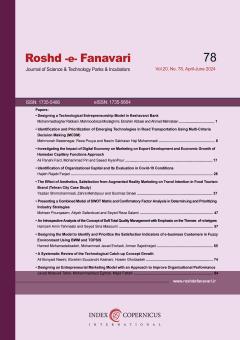-
-
List of Articles
-
Open Access Article
1 - Designing a Technological Entrepreneurship Model in Keshavarzi Bank
mohammadbagher rabbani mahmoodreza mostaghimi Ahmad Mehrabian Ibrahim Abbasi -
Open Access Article
2 - Identification and Prioritization of Emerging Technologies in Road Transportation Using Multi-Criteria Decision Making (MCDM)
mehrnoosh bastenegar Reza Pouya Nasrin Sakhaian Haji Mohammadi -
Open Access Article
3 - Investigating the Impact of Digital Economy on Marketing on Export Development and Economic Growth of Hamedan Capillary Functions Approach
ali panahi fard Mohammad piri Saeed KiyanPour -
Open Access Article
4 - Identification of Organizational Capital and Its Evaluation in Covid-19 Conditions
hajieh rajabi farjad -
Open Access Article
5 - The Effect of Aesthetics, Satisfaction from Augmented Reality Marketing on Travel Intention in Food Tourism Brand (Tehran City Case Study)
Yazdan Shirmohammadi Zahra Mehdipour Sinaei Soolmaz -
Open Access Article
6 - Presenting a Combined Model of SWOT Matrix and Confirmatory Factor Analysis in Determin.ing and Prioritizing Industry Strategies
mohsen pourqasem atiyeh safardoust Seyed reza Salami -
Open Access Article
7 - An Introspective Analysis of the Concept of Soft Total Quality Management with Emphasis on the Themes of Archetypes
Hamzeh Amin-Tahmasbi S. Sina Masoumi -
Open Access Article
8 - Designing the Model to Identify and Prioritize the Satisfaction Indicators of e-business Customers in Fuzzy Environment Using BWM and TOPSIS
Hamed Mohamadalizadeh Mohammad Javad Ershadi Arman Sajedinejad -
Open Access Article
9 - A Systematic Review of the Technological Catch-up Concept Growth
علی بنيادی نائينی Ebrahim Souzanchi Kashani Hosein Gholizadeh -
Open Access Article
10 - Designing an Entrepreneurial Marketing Model with an Approach to Improve Organizational Performance
javad motevali taher mohammadreza eghbal مجید فتاحی
-
The rights to this website are owned by the Raimag Press Management System.
Copyright © 2017-2026







